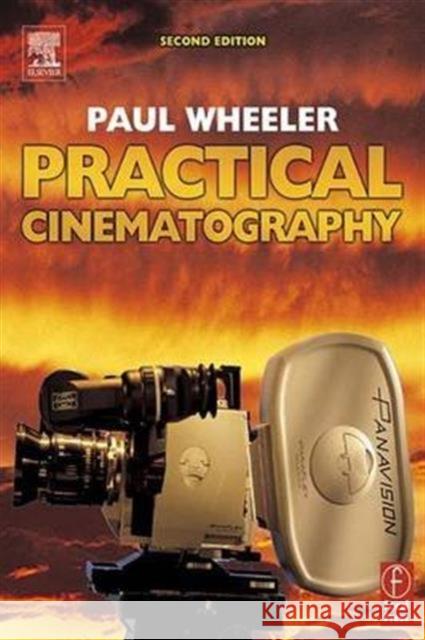Practical Cinematography » książka



Practical Cinematography
ISBN-13: 9781138174429 / Angielski / Twarda / 2015 / 224 str.
Practical Cinematography
ISBN-13: 9781138174429 / Angielski / Twarda / 2015 / 224 str.
(netto: 670,84 VAT: 5%)
Najniższa cena z 30 dni: 680,04
ok. 22 dni roboczych
Dostawa w 2026 r.
Darmowa dostawa!
First Published in 2005. Routledge is an imprint of Taylor & Francis, an informa company.
'I've attended one of Paul's lectures and although this book can only contain a part of his humour, a fraction of his experience and a hint of his enthusiasm it's a wonderful source of knowledge. It will provide a valuable insight to all budding cinematographers who should read it, learn it and then go out and make a film (not a video... a film)!'
Online bookseller's reader review
"The author covers in great detail the many aspects of the production of a motion picture from the director of photography's point of view and responsibility. He does this in a very understandable and interesting style."
-John Leak, ACS, Australian Cinematographer magazine,
PART ONE The unit
The Director of Photography
The DP's Responsibilities
In early Pre-production
Closer to shoot preparation
During shooting
Post production
The DP's Preparation
Research
Preparing for a shoot
The recces
The DP's preparation
The camera equipment list
The lighting equipment list
The film stock breakdown
The technical schedule
The Camera Crew
An Overview
The Trainee
The Clapper Loader (AC 2)
The Focus Puller (AC 1)
The Camera Operator
The Grip
The Gaffer
Crew Protocol
PART TWO The Technology
The Motion Picture Camera
The Persistence of Vision
Frame Rates
The Intermittent Mechanism
The Reflex Viewfinder
Viewing Screens
The Film Magazine
Film Camera Layout
Lenses
Artistic Decisions
Characteristics of Lenses
The Fundamentals
Perceived sharpness with regard to contrast
Maximum aperture
Telephoto lenses
Wide-angle lenses
Zooms
Conclusions
Choice
Modern Lens Designs
Lens Distortion and Aberrations
Film Stock
What is Film?
The history of the negative/positive photographic process
The basic photographic process
Colour Negative Film
Grain and Graininess
When does Grain become unacceptable?
Perforations
Edge Numbers
Care, Shipping and Handling
Basic Sensitometry
The Laboratory
The Laboratory Contact
Printer Lights
Contact Printing
Optical Printing
Negative Cutting
Cinema Release Prints
The "Long Handled Negative Cut
Film Grading
Telecine Grading
PART THREE The Cinematographers Craft
Exposure Meters
Camera Speed
Shutter Speed
Average Scene Reflectance Value
Types of Exposure Meter
Lighting Ratios
Defining a Lighting Ratio
Visualising Lighting Ratios
Lighting Ratios for Film and Television
Lighting Ratios when shooting for both Film and
Television
Using Lighting Ratios on the Set
Controlling the Whole Scene
Three Point Image Control
There's no such thing as exposure latitude
Three Point Image Control
Relating the three points to the sensitometric curve
Control for television
Using the 18% Grey Scale
The Messenger
Controlling Print Density
Shifting Colour
Intentional Colour Changes
Developments in Grey Cards
Conclusions
Colour Temperature
What is Colour Temperature?
Filters and Mired Shift Values
The Colour Temperature Meter
Colour Film
Correcting Lamps
Camera Filters
Colour Compensating Filters
Colour Correction Filters
Skin Tone Warmer
Sepia, Coral, colour effects, etc.
Graduated Filters
Neutral Density
Low Contrast
Ultra Contrast
Fog
Double fog
Pro Mist
Star filters
Nets
Matching Shots
Enhancing Filters
Fluorescent Light Correction
Pola Screens
Filter Factors
The Pan Glass
Depth of Field
Depth of Focus
Circles of Confusion
Depth of Field and Super 16mm to 35mm Blow Ups
Super 16mm and 16 x 9 Television
35mm Film Depth of Field when only shown on Television
Depth of Field Calculators
The Effect of Aperture on Depth of field
The Effect of Focal Length on Depth of Field
The Mathematics of Depth of Field
Testing
Why so much checking?
Who Checks?
Tests that involve shooting film include:
Lens Testing
Gamma Testing
What to do with the Film Tests
Non Film Testing
Stores
The Camera Car
PART FOUR Operating
Composition and the Rule of Thirds
Framing using the Rule of Thirds
Framing using the Sixths
Diagonal Framing
Complex and Combined Composition
Lenses and Perspective
Frame Size and Focal Length
Perspective
Focal length and emotional involvement
What is a Normal focal length?
Aspect Ratios
The 35mm Frame
The Aspect Ratio
Widescreen
Three Perforation Pull Down
Two perforation pull down
Anamorphic
65mm and 70mm
Super 35
Television
PART FIVE The Future
Shooting Super 16mm for Television
Aspect Ratios when shooting for television
History - The evolution of the Super 16mm format
16 x 9 Television and Super 16
Framing in several formats
Framing Solutions
Festival Prints
High Definition
HD - is it the future?
Picture Quality
HD Acquisition
Multi episodic
Features
Television
Editing HD
Presentation
Distribution
Cinema projection
Will Digital Cinema come?
So, film is not dead!
Paul Wheeler BSC FBKS was trained at the BBC rising to become a Senior Drama Film Cameraman. Paul Shot one of the first BBC Drama Series to be photographed using the then new Digi Beta cameras, by which time he was freelance. He is a renowned cinematographer/director of photography and trainer, he has been Head of Cinematography at National Film & Television School and still runs courses on Digital Cinematography there. He has also been Head of Cinematography on the Royal College of Arts MA course. Paul was invited to become an associate of Panavision in order to help them introduce the Panavised version of Sony's HDW 900f camera which meant he joined the HD movement 3 days before the first Panavision camera arrived in Europe. Despite all this he is still very much a working cinematographer. He has been twice nominated by BAFTA for a Best Cinematography award and also twice been the winner of the INDIE award for Best Digital Cinematography. His previous books, "Practical Cinematography and "Digital cinematography, are both published by the Focal Press.
1997-2025 DolnySlask.com Agencja Internetowa
KrainaKsiazek.PL - Księgarnia Internetowa









